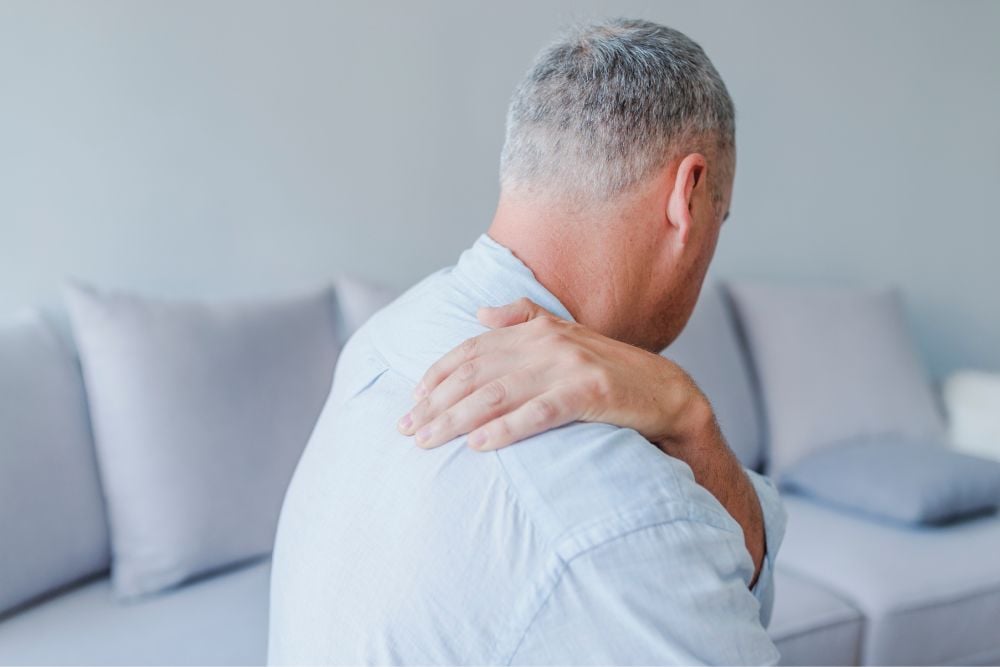
Shoulder bursitis involves the fluid sacs (i.e., bursae) surrounding your shoulder joints. Inflammation in these fluid sacs can lead to shoulder pain and limitation of normal range of motion and movement. If you have shoulder pain, it’s essential to understand the potential causes, symptoms, and available treatment options and how an orthopedic specialist can provide valuable insights into pain management and non-surgical treatment options. Here's an overview of the causes, symptoms, and long-term treatment options for shoulder bursitis.
What is Shoulder Bursitis?
Shoulder bursitis, also known as subacromial bursitis, is an inflammatory condition that causes pain and discomfort. As a result, your shoulder and arm may have a limited range of motion. Shoulder bursitis occurs when the bursae fluid sacs of the shoulder become inflamed. The bursae cushion muscles, tendons, and bones near these joints, reducing friction and facilitating smooth movements.
Causes of Shoulder Bursitis
Bursitis can be caused by a wide variety of activities, including:
- Overuse and repetitive movements (e.g., throwing, lifting, or reaching)
- Injury or trauma to the shoulder (e.g., falling on the shoulder, which can damage the bursa and trigger inflammation)
- Prolonged poor posture (such as slouching or hunching) can push the top of your shoulder and rotator cuff together, putting pressure on the bursa sacs, and possibly contributing to bursitis over time
- Degeneration of the bursa and surrounding tissues (which may occur with age); degeneration can cause or exacerbate inflammation throughout the shoulder, including the bursa
Symptoms of Shoulder Bursitis
Symptoms of shoulder bursitis commonly include:
- Pain and discomfort (the pain may be sharp, aching, or throbbing and increase with movements that involve reaching overhead or lifting the arm)
- Shoulder pain that increases when you put pressure on the painful area
- Pain when resting
- Tenderness, redness, or swelling due to inflammation
- Reduced range of motion
If you have extreme joint pain, swelling or rash in the area, shooting pain when you move the joint, an inability to move the joint, or any of these symptoms combined with a fever, it’s essential to seek medical attention.
Shoulder Bursitis Treatment Options
Mild shoulder bursitis symptoms can often be managed by discontinuing the movement that causes pain, resting the affected joint, and taking over-the-counter pain medications. While these home remedies may temporarily alleviate shoulder pain, flare-ups commonly occur later. It’s essential to learn how to protect the affected joint from further trauma.
Long-term treatment should be managed by an orthopedic specialist with expertise in non-surgical pain management therapies. In severe cases of bursitis, surgical intervention may be required. When surgery is needed, experienced orthopedic surgeons can help reduce your pain and speed up your recovery process.
Common non-surgical treatment options for shoulder bursitis include:
- Rest and Activity Modification – Resting the affected shoulder and avoiding activities that aggravate the pain can help reduce inflammation. Modifying movements to avoid repetitive or overhead actions is also beneficial.
- Physical Therapy – Physical therapists can design a customized exercise program to strengthen shoulder muscles, improve flexibility, and correct posture, which often speeds recovery.
- Pain Medications – Ibuprofen and other nonsteroidal anti-inflammatory drugs (NSAIDs) are commonly used medications for treating pain and reducing inflammation.
- Corticosteroid Injections – Corticosteroid injections may be administered directly into the bursa to reduce swelling and pain in severe cases of pain and inflammation from bursitis.
- Supportive Devices – Slings and braces can immobilize the shoulder, helping to promote healing.
Preventative Measures
To prevent injuries to the shoulder that could contribute to bursitis, take the following precautions:
- Limit repeated lifting motions
- Stretch properly
- Use good body mechanics
- Take breaks from continuous activities
Advanced Orthopedic Care for Shoulder Bursitis in NJ
At The Orthopedic Health Center, our orthopedic specialists have extensive experience treating shoulder bursitis, and our goal is to help you feel better as soon as possible. If you feel that your shoulder pain may be caused by bursitis or you have severe unrelieved symptoms of shoulder pain, contact us today to schedule a consultation at our Hoboken, Jersey City, and Bayonne, NJ office locations. We can answer any questions, accurately diagnose your shoulder pain, and provide a comprehensive, personalized treatment plan to help manage your pain.
Appointments available now.
